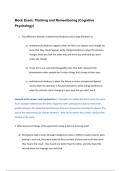Exam (elaborations)
Ultimate Mock Exam 2.1C (Cognitive PSychology (Thinking and Remembering) with Elaborate answers
- Course
- Institution
This exam was made based on the most important aspects of every topic, and covers all parts of the problem ( from A to C). It has very elaborate answers that can serve as a quick and efficient summary before the exam.
[Show more]



